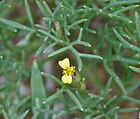Note: This is a project under development. The articles on this wiki are just being initiated and broadly incomplete. You can Help creating new pages.
Glossocardia bosvallia
Glossocardia bosvallia It is a small annual herb. It can grow upto 10-20cm in height. The plant is branched from the base and the branches are grooved.
Contents
- 1 Uses
- 2 Parts Used
- 3 Chemical Composition
- 4 Common names
- 5 Properties
- 6 Habit
- 7 Identification
- 8 List of Ayurvedic medicine in which the herb is used
- 9 Where to get the saplings
- 10 Mode of Propagation
- 11 Cultivation Details
- 12 Commonly seen growing in areas
- 13 Photo Gallery
- 14 References
- 15 External Links
Uses
Food
Glossocardia bosvallia can be used in Food. Whole plant is cooked as vegetable.
Parts Used
Chemical Composition
Common names
| Language | Common name |
|---|---|
| Kannada | Parpataka |
| Hindi | Pattharsuva |
| Malayalam | |
| Tamil | Parapalanam |
| Telugu | Parapalanam |
| Marathi | Phattar-suva |
| Gujarathi | |
| Punjabi | |
| Kashmiri | |
| Sanskrit | Charak |
| English | Patthar Suva |
Properties
Reference: Dravya - Substance, Rasa - Taste, Guna - Qualities, Veerya - Potency, Vipaka - Post-digesion effect, Karma - Pharmacological activity, Prabhava - Therepeutics.
Dravya
Rasa
Guna
Veerya
Vipaka
Karma
Prabhava
Nutritional components
Glossocardia bosvallia Contains the Following nutritional components like - Vitamin-B1, B2, B3 and C; Ursolic acid, Lupeol, Coumarin, Sterols, Lignins; Ionone glycosides; Phenyl propanoides; Flavonoides; Calcium, Copper, Iron, Magnesium, Manganese, Phosphorus, Potassium, Sodium, Zinc[3]
Habit
[[:Category:Habit - |]]
Identification
Leaf
| Kind | Shape | Feature |
|---|---|---|
| Alternately arranged | 1.5cm long | Pinnately cut into linear segment |
Flower
| Type | Size | Color and composition | Stamen | More information |
|---|---|---|---|---|
| Outer 3 bracts are 3m long | Yellow | Yellow borne in heads carried on slender stalks, In leaf axils or at the end of the branchs | {{{5}}} |
Fruit
| Type | Size | Mass | Appearance | Seeds | More information |
|---|---|---|---|---|---|
Other features
List of Ayurvedic medicine in which the herb is used
Where to get the saplings
Mode of Propagation
[[:Category:Index of Plants which can be propagated by |]]
Cultivation Details
Glossocardia bosvallia is available through August-December.[5]
Commonly seen growing in areas
[[:Category:Herbs that are commonly seen in the region of |]], [[:Category:Herbs that are commonly seen in the region of |]], [[:Category:Herbs that are commonly seen in the region of |]], [[:Category:Herbs that are commonly seen in the region of |]], [[:Category:Herbs that are commonly seen in the region of |]].
Photo Gallery
References
- ↑ Indian Medicinal Plants by C.P.Khare
- ↑ [Chemistry]
- ↑ Forest food for Northern region of western ghat pdf by Dr. Mandar N. Datar and Dr. Anuradha S. Upadhye, MACS - Agharkar Research Institute, Pune
- ↑ Kappatagudda - A Repertoire of Medicianal Plants of Gadag by Yashpal Kshirasagar and Sonal Vrishni, Page No. 200
- ↑ [Cultivation]
External Links
- Ayurvedic Herbs known to be helpful to treat Sores
- Ayurvedic Herbs known to be helpful to treat Wound
- Herbs with Whole plant used in medicine
- Herbs with common name in Kannada
- Herbs with common name in Hindi
- Herbs with common name in Tamil
- Herbs with common name in Telugu
- Herbs with common name in Marathi
- Herbs with common name in Sanskrit
- Herbs with common name in English
- Habit -
- Index of Plants which can be propagated by
- Herbs that are commonly seen in the region of
- Herbs
- Pages without herbs images




